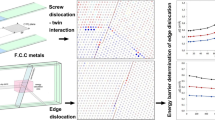Abstract
We present an application of the discrete dislocation theory to the characterization of the energetics of kinks in Mo, Ta and W body-centered cubic (BCC) crystals. The discrete dislocation calculations supply detailed predictions of formation and interaction energies for various double-kink formation and spreading mechanisms as a function of the geometry of the double kinks, including: the dependence of the formation energy of a double kink on its width; the energy of formation of a double kink on a screw dislocation containing a pre-existing double kink; and energy of formation of a double kink on a screw dislocation containing a pre-existing single kink. The computed interaction energies are expected to facilitates the nucleation of double kinks in close proximity to each other and to pre-existing kinks, thus promoting clustering of double kinks on screw segments and of ‘daughter’ double kinks ahead of ‘mother’ kinks. The predictions of the discrete dislocation theory are found to be in good agreement with the full atomistic calculations based on empirical interatomic potentials available in the literature.
Similar content being viewed by others
References
Ariza MP, Ortiz M (2005) Discrete crystal elasticity and discrete dislocations in crystals. Arch Ration Mech Anal 178: 149–226
Ariza MP, Ortiz M (2010) Discrete dislocations in graphene. J Mech Phys Solids 58: 710–734
Babuska I, Vitasek E, Kroupa F (1960) Some applications of the discrete fourier transform to problems of crystal lattice deformation, parts i and ii. Czechoslovak J Phys 10:419–427; 488–504
Cai W, Bulatov V, Justo JF, Argon AS, Yip S (2000) Intrinsic mobility of a dissociated Dislocation in silicon. Phys Rev Lett 84(15): 3346–3349
Cai W, Bulatov V, Yip S, Argon AS (2001) Kinetic Monte Carlo modeling of dislocation motion in BCC metals. Mater Sci Eng A 309(SI): 270–273
Dai X, Kong Y, Li J, Liu B (2006) Extended Finnis–Sinclair potential for bcc and fcc metals and alloys. J Phys Condens Matter 18: 4527–4542
Duesbery M (1983) On kinked screw dislocations in the bcc lattice. II. Kink energies and double kinks. Acta metallurgica 31(10): 1759–1770
Ericksen JL (1979) On the symmetry of deformable crystrals. Arch Ration Mech Anal 72: 1–13
Finnis M, Sinclair J (1984) A simple empirical n-body potential for transition-metals. Philos Mag A Phys Condens Matter Struct Defects Mech Prop 50(1): 45–55
Ghoniem NM, Tong SH, Sun LZ (2000) Parametric dislocation dynamics: a thermodynamics-based approach to investigations of mesoscopic plastic deformation. Phys Rev B 61(2): 913–927
Hirth JP, Lothe J (1968) Theory of dislocations. McGraw-Hill, New York
Koslowski M, Cuitiño A, Ortiz M (2002) A phase-field theory of dislocation dynamics, strain hardening and hysteresis in ductile single crystals. J Mech Phys Solids 50(12): 2597–2635
Madec R, Devincre B, Kubin LP (2002) Simulation of dislocation patterns in multislip. Scripta Materialia 47(10): 689–695
Munkres JR (1984) Elements of algebraic topology. Perseus Publishing, Cambridde, MA
Mura T (1987) Micromechanics of defects in solids. Kluwer, Boston
Nye JF (1953) Some geometrical relations in dislocated crystals. Acta Metallurgica 1: 153–162
Ramasubramaniam A, Ariza MP, Ortiz M (2007) A discrete mechanics approach to dislocation dynamics in bcc crystals. J Mech Phys Solids 55(3): 615–647
Seeger A (1981) The kink picture of dislocation mobility and dislocation-point-defect interactions. Journal de Physique 42(NC5): 201–228
Shenoy VB, Ortiz M, Phillips R (1999) The atomistic structure and energy of nascent dislocation loops. Model Simul Mater Sci Eng 7(4): 603–619
Tang M, Kubin LP, Canova GR (1998) Dislocation mobility and the mechanical response of BCC single crystals: a mesoscopic approach. Acta Materialia 46(9): 3221–3235
Vitek V (1976) Computer-simulation of screw dislocation-motion in bcc metals under effect of external shear and uniaxial stresses. Proc R Soc Lond Ser A 352(1668): 109–124
Wang YU, Jin YM, Cuitino AM, Khatachuryan AG (2001) Nanoscale phase field microelasticity theory of dislocations: model and 3d simulations. Acta Materialia 49(10): 1847–1857
Wang YU, Jin YM, Cuitino AM, Khatachuryan AG (2004) Phase field microelasticity theory and modeling of multiple dislocation dynamics. Appl Phys Lett 78(16): 2324–2326
Xu W, Moriarty J (1998) Accurate atomistic simulations of the Peierls barrier and kink-pair formation energy for 〈111〉 screw dislocations in bcc Mo. Comput Mater Sci 9: 348–356
Yang L, Soderlind P, Moriarty J (2001) Accurate atomistic simulation of a/2 〈111〉 screw dislocations and other defects in bcc tantalum. Philosoph Mag A 1(5): 1355–1385
Yang LH, Moriarty JA (2001) Kink-pair mechanisms for a/2 〈111〉 screw dislocation motion in bcc tantalum. Mater Sci Eng A 319(SI): 124–129
Zbib HM, de la Rubia TD, Bulatov VV (2002) A multiscale model of plasticity based on discrete dislocation dynamics. Int J Mech Sci 124(1): 78–87
Author information
Authors and Affiliations
Corresponding author
Rights and permissions
About this article
Cite this article
Ariza, M.P., Tellechea, E., Menguiano, A.S. et al. Double kink mechanisms for discrete dislocations in BCC crystals. Int J Fract 174, 29–40 (2012). https://doi.org/10.1007/s10704-012-9681-7
Received:
Accepted:
Published:
Issue Date:
DOI: https://doi.org/10.1007/s10704-012-9681-7



